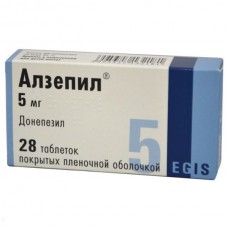Expiration date: 05/2025
The composition and form of issue:
Tablets, film-coated. 1 tablet contains:
donepezil hydrochloride monohydrate of 5.21 mg
10,42 mg
(corresponds to donepezil hydrochloride 5 or 10 mg)
excipients: MKC — 96/192 mg hydroxypropyl cellulose with a low degree of substitution (L-HPC B1) 24/48 mg of magnesium stearate 1/2 mg Opadry Y-1-7000 white — 3/6 mg hypromellose — 1,875/3.75 mg titanium dioxide of 0.9375/1,875 mg macrogol 400 — 0,1875/0,375 mg
in blisters of polyamide/aluminium foil or PVC/PVDC/aluminium foil, 14 PCs. in cardboard pack 2, or 4 blisters.
Description pharmaceutical form:
Tablets 5 mg: white or almost white, round, biconvex, film-coated, without or almost odourless, with engraving "E 381" on one side.
Tablets 10 mg: white or almost white, round, biconvex, film-coated, without or almost odourless, with engraving "E 382" on one side.
Pharmacokinetics:
Suction. Cmax of donepezil in plasma after oral administration are reached in approximately 3-4 h. plasma Concentrations and AUC increase proportionally with dose. T1/2 is about 70 hours, so the systematic use of single doses leads to the achievement of the equilibrium state that is achieved within 2-3 weeks after the start of therapy. CSS donepezil in plasma and the related pharmacodynamic activity change slightly during the day. Eating does not affect the absorption of donepezil.
Distribution. The plasma protein binding is 95%. About the plasma protein binding of the active metabolite 6-O-desmethyldonepezil is unknown. The distribution has not been studied. Donepezil and/or its metabolites can persist in the body for more than 10 days.
Metabolism and excretion. Donepezil undergoes metabolism in the liver and excreted as its metabolites formed by cytochrome P450, mainly by the kidneys unchanged: approximately 57% of the administered dose was detected in urine (17% in an unmodified form) and 14.5% in the stool.
After receiving a single dose of 5 mg, the concentration of unchanged donepezil in plasma is 30% of the dose, 6-O-desmethyldonepezil — 11% (the only metabolite with similar activity with donepezil hydrochloride), donepezil-CIS-N-oxide — 9%, 5-On-desmethyldonepezil — 7% and glukuronova conjugate 5-O-desmethyldonepezil — 3%. T1/2 of donepezil is about 70 hours
Gender, race and Smoking do not have a significant effect on the concentration of donepezil in plasma.
In patients with mild or moderate hepatic impairment may experience increased CSS of donepezil in the blood plasma.
Description pharmacological action:
Donepezil is a selective and reversible inhibitor of acetylcholinesterase, which is the main predominant cholinesterase in the brain. Donepezil inhibits this enzyme more than 1,000 times stronger than butylcholinesterase the enzyme that is present mainly outside the Central nervous system.
A single dose of 5 or 10 mg in the equilibrium state is accompanied by inhibition of cholinesterase activity (assessed in the membranes of red blood cells) by 63.6 and 77.3%, respectively. Slows the progression of Alzheimer's disease, reduces the severity of cognitive symptoms, in some cases, restores daily activity sick and easier to care for them. Corrects behavioral violations, decreases apathy, hallucinations, and unconscious repetitive movement.
Indications:
Dementia of Alzheimer's type mild, moderate and severe degrees (symptomatic treatment).
Contraindications:
- hypersensitivity (W. to derive piperidine)
- pregnancy
- lactation
- children up to age 18 years (due to lack of clinical data).
With caution: COPD, asthma, heart rhythm disorders, General anesthesia, gastric ulcer and duodenal ulcer, concomitant use of NSAIDs, anticholinergics and other cholinesterase inhibitors.
Application of pregnancy and breast-feeding:
Experience of use during pregnancy and lactation no. Unknown, selects whether the drug in breast milk. Therefore, the use during pregnancy is contraindicated, in case of need of the drug during lactation should decide the issue of termination of breastfeeding.
Side effects:
Depending on the frequency of side effects are defined as follows: very often — &ge1/10 often — &ge1/100, but &le1/10 rare — &ge1/1000, but &le1/100, rare &ge1/10000, &le1/1000, very rare &le1/10000.
From the CCC: often — aetiology, rarely sinoatrialnaya blockade, AV blockade.
In the Central and peripheral nervous system: often — faint*, fatigue, dizziness, headache, muscle cramps, insomnia, hallucinations, agitation, aggressive behavior rarely — convulsive seizures* rare — extrapyramidal symptoms.
On the part of the digestive tract: very often — diarrhea, nausea, often vomiting, dyspepsia, anorexia, gastrointestinal disorder rare — bleeding from the gastrointestinal tract, gastric ulcer and duodenal ulcer.
The kidneys, urinary organs and liver: often — urinary incontinence, rarely — liver dysfunction, including hepatitis.
The skin and subcutaneous tissue: often — rash, itching.
Laboratory tests: rare — a slight increase in the activity of muscle isoforms of creatine kinase in serum.
Other: pain of various localization, a cold.
* The evaluation of patients with syncope and seizures should consider the possibility cardiac blockade.
Drug interactions:
Donepezil and/or products of its metabolism are not inhibit the metabolism of theophylline, warfarin, cimetidine, digoxin, thioridazine, risperidone and sertraline.
Concomitant use of cimetidine, digoxin, thioridazine, risperidone and sertraline does not affect the metabolism of donepezil.
The use of donepezil concomitantly with levodopa/carbidopa for 21 days had no effect on the concentration of these drugs in the blood.
In the metabolism of donepezil involves the cytochrome P450 isoenzyme CYP3A4 and, to a lesser extent, — CYP2D6. Ketoconazole and quinidine, which are inhibitors of CYP3A4 and CYP2D6, respectively, inhibit the metabolism of donepezil. Therefore these and other CYP3A4 inhibitors such as Itraconazole and erythromycin, and CYP2D6 inhibitors, such as fluoxetine, may inhibit the metabolism of donepezil. In healthy volunteers, ketoconazole increased mean concentrations of donepezil by approximately 30%. Concurrent use of donepezil has no effect on the pharmacokinetics of ketoconazole.
Enzyme inducers, such as rifampicin, phenytoin, carbamazepine and ethanol can cause a decrease in the level of donepezil. However, the degree of such inhibitory or inducing effects are not known, therefore, to use similar means in combination with donepezil should be careful.
Donepezil has an effect on the action of drugs with anticholinergic activity. In addition, while the use of donepezil may increase the effects of suxamethonium bromide, other muscle relaxants or cholinergic receptor agonists and beta-blockers that affect cardiac conduction.
While the use of donepezil and the cholinergic receptor agonists, Quaternary anticholinergics such as glycopyrrolate bromide, described cases of atypical changes of BP and HR.
Method of application and dose:
Inside the evening, before bedtime.
Treatment starts with 5 mg of 1 times a day and continued for at least 4 weeks to achieve equilibrium concentrations of donepezil and evaluate the early clinical effect of therapy.
After 1 month the dose can be increased to a maximum recommended daily dose — 10 mg 1 time per day.
Maintenance therapy can continue as long as the therapeutic effect, which should be regularly assessed.
Patients with impaired liver and kidney. Patients with hepatic impairment mild and moderate severity and with the impairment of renal function will not need to modify treatment regimens, because these States do not affect creatinine clearance.
Overdose:
Symptoms: cholinergic crisis (severe nausea, vomiting, salivation, sweating, bradycardia, decreased blood pressure, respiratory depression, collapse, convulsions). Possible increasing myasthenia gravis, which can result in death if respiratory muscles.
Treatment: symptomatic therapy. As an antidote — the appointment of atropine in/in initial dose of 1-2 mg, then dose adjusted depending on the effect. Unknown, removed whether donepezil and/or its metabolites by dialysis (hemodialysis, peritoneal dialysis, hemofiltration).
Special instructions:
Maintenance therapy can continue as long as the therapeutic effect. In this regard, should be conducted to assess the effect of donepezil. If the drug ceases to act, it should be abolished. After stopping treatment, a gradual decrease in the action of the drug, the withdrawal syndrome in case of sudden discontinuation of the drug. Individual response to donepezil therapy cannot be predicted.
Donepezil may increase the severity of the neuromuscular blockade caused by depolarizing muscle relaxants during General anesthesia.
Cholinesterase inhibitors may have vagotonic effects on heart rate (in particular to cause bradycardia). The potential for this action may be important for patients with the syndrome sick sinus or other supraventricular cardiac conduction conditions, such as sinoatrial block and AV block.
During treatment it is necessary to carefully observe patients who have a risk of developing ulcers of the stomach and duodenum, for example in patients with gastric ulcer history, or patients receiving NSAIDs, because cholinomimetics may increase the secretion of hydrochloric acid in the stomach. At the same time, clinical studies have not noted an increase in the frequency of developing peptic ulcers or gastrointestinal bleeding compared with placebo.
Cholinesterase inhibitors can cause urinary retention, although this effect was not found in the clinical studies.
I believe that the cholinesterase inhibitors to a certain extent can cause generalised convulsions, however seizure activity may also be manifestation of dementia of Alzheimer's type.
Given the nicotinic effects of cholinesterase inhibitors they should be administered with caution to patients with bronchial asthma or obstructive pulmonary disease in anamnesis.
Effects on ability to drive vehicles and working with machinery. Dementia of Alzheimer's type itself may be accompanied by impaired ability to drive a car and use complicated equipment. In addition, the drug, mainly at the beginning of treatment can cause fatigue, dizziness and muscle cramps. The question about the ability of the patient with dementia Alzheimer's type while taking donepezil to drive or use complex equipment should be decided by the doctor after assessing individual patient response to treatment.



